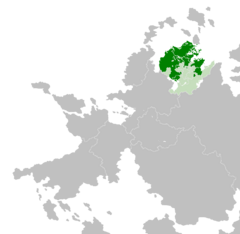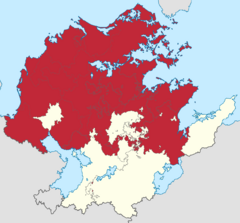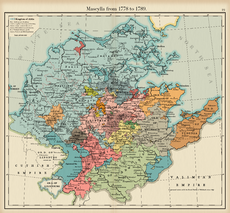Elbgau Confederation
This article is incomplete because it is pending further input from participants, or it is a work-in-progress by one author. Please comment on this article's talk page to share your input, comments and questions. Note: To contribute to this article, you may need to seek help from the author(s) of this page. |
Elbgau Confederation Elbgaubund | |
|---|---|
| 1785–1793 | |
 The Elbgau Confederation upon its establishment in 1785: member states in green, remaining Mascyllary states in light green | |
 | |
| Capital | Langquaid (1785–87) Augusthal (1787–1793) |
| Common languages | Hesurian · Cuthish · Waldish · Temarian · Valimian · Cuthish · Falian |
| Religion | Semitarism |
| Government | Federal association of Mascyllary sovereign states |
| President of the Präsidialmacht | |
• 1785–1793 | Lucas I |
| Legislature | Federal Senate (Bundessenat) |
| Historical era | 1785–1793 |
| 20 December 1785 | |
• Constitution adopted | 8 January 1786 |
| 1789–1793 | |
• Treaty of Langquaid | 18 May 1793 |
| Population | |
• 1790 | 22,830,150 |
| Currency | Mascyllary Unionsthaler (1785–1790) Mascyllary Karning (1790–1793) |
| Today part of | |
Part of a series on the |
|---|
| History of Mascylla |
 |
|
|
The Elbgau Confederation (Hesurian: Elbgaubund, pronounced: [ˈɛlpgaʊ̯bʊnt]), also referred to as the Elbgau Confederacy or North Mascyllary Confederation (Hesurian: Nordmaskillischer Bund) was a Mascyllary federal idiosyncratic association of initially 11 sovereign states from its establishment by the Congress of Rehnern on 20 December 1785 until its dissolution by the Treaty of Langquaid on 18 May 1793. Although in essence a confederacy of states of equal stance, it was militarly, politically and economically dominated by the Kingdom of Aldia, the confederation's largest and most powerful member state.
Following its creation, the confederation became a vehicle for states, most notably Aldia itself, to bring about the Mascyllary unification which was ultimately reached by the outcome of the War of the Five Kings; and by the dissolution of the confederation in light of its succeeding Mascyllary Kingdom, again under Aldian supervision and control, as a unified nation state. While attempts had been made by Adwhin to establish a counterweight to the confederation with the remaining neutral Mascyllary states, efforts proved fruitless and led to a dramatic rise in tensions between Aldia and Adwhin. Furthermore, the rapid decline of the First Cuthish Empire destabilized the delicate balance of powers of Mascylla.
Due to Aldia's significance in the confederation King Albert William I's successor Lucas I was awarded the position of head of state as President of the Bundespräsidium, de facto exercising full control over the confederation; federal law could only be enabled by the approval of the Federal Senate (Bundessenat) composed of elected or appointed envoys of the member states. With the onset of the Cuthish Revolution in 1789, the Elbgau Confederation gradually repurposed itself from an opportunistic alliance of sovereign states into an increasingly nationalistic project; Lucas I of Aldia spearheaded this development, recognizing its potential to amplify Aldian power in an united Mascylla on the grounds of Mascyllary patriotism and nationalism (Maskenfrage). However, he disapproved of the introduction of Enlightened liberalist and other revolutionary ideas.
Today, most historians consider the Elbgau Confederation to be a mere puppet or instrument of Aldia, ineffective and indecisive in enforcing its own political views in favor of an Aldian vision of Mascyllary unification. However, it is seen as a major milestone of Mascyllary unification both politically, but also economically (via the North Mascyllary Customs Union (Nordmaskillischer Zollverein) in the 1760s) and to a broader extent, socially, embodying a symbol of unity among its member states. It was also among the first proto democracies in Mascyllary history and many of its institutional features are still reflected in the Crowned Republic's political system today.

